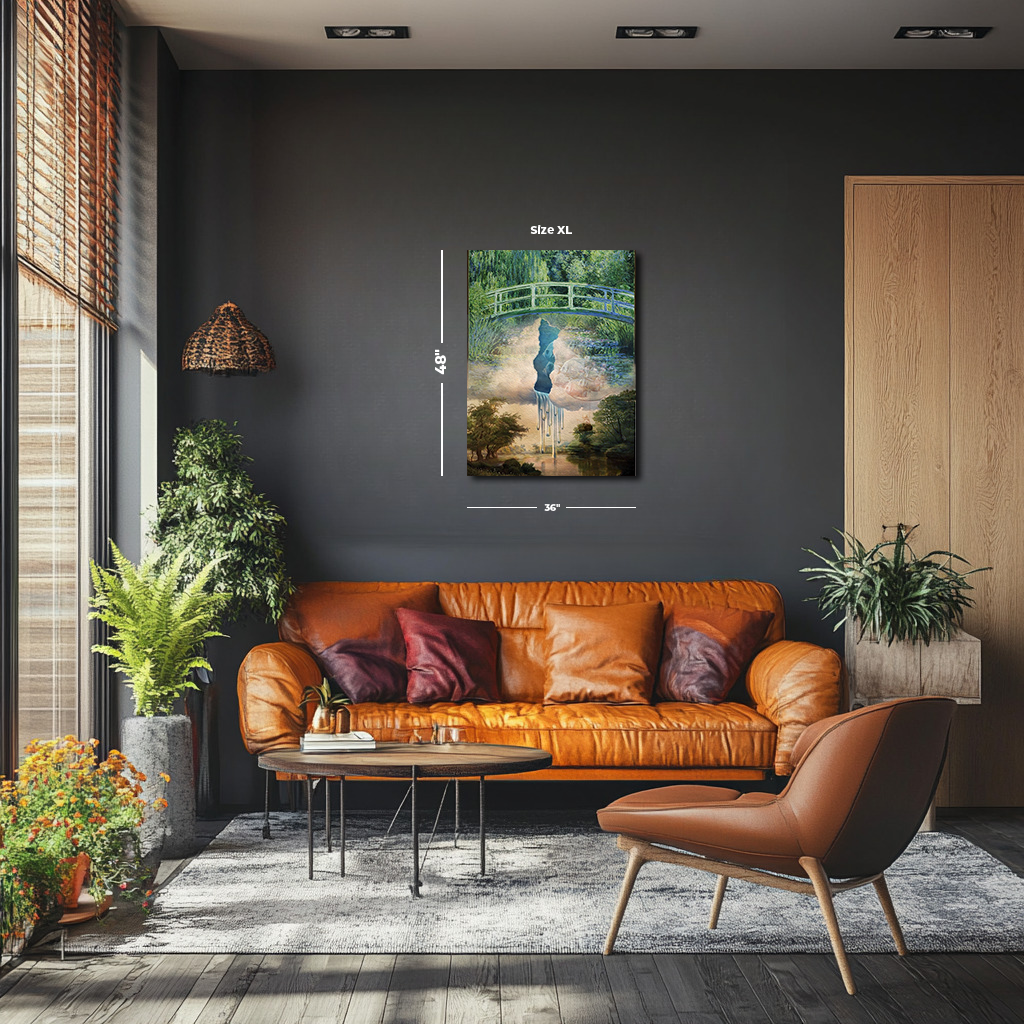The Tear Between Realms: A Monet Reverie Reimagined
"The Tear Between Realms: A Monet Reverie Reimagined" blends the serenity of Claude Monet's iconic Impressionist style with the boundless imagination of surrealism. Inspired by "The Japanese Bridge" from Monet’s Giverny garden, this piece reinterprets the tranquil scene by introducing a surreal rift in the sky, cascading liquid tears that connect the celestial and the earthly. Ghostly fish drift through the clouds, and a solitary figure floats on a serene river, symbolizing humanity's fragility and resilience. The artwork explores themes of beauty, impermanence, and introspection, inviting viewers to reflect on their place within nature and the universe.
Please see Below for Details…
Hotline Order:
Mon - Fri: 07AM - 06PM
404-872-4663
Claude Monet, a cornerstone of the Impressionist movement, is renowned for his delicate exploration of light, water, and nature, which forever altered the trajectory of modern art. This artwork, while deeply rooted in Monet’s signature style, transcends its original inspirations to form a surrealistic dialogue between naturalism and dreamscapes. The piece appears to reimagine one of Monet's iconic works, "The Japanese Bridge," from his garden at Giverny, where reflections of water lilies on tranquil ponds served as metaphors for the transience of life. In this rendition, however, the pastoral serenity is interrupted by an existential rift—a surreal cascade of liquid pouring from a cloud's core, merging dream and reality into a poignant visual allegory.
The bridge in this artwork retains the symbolic gravity of Monet’s original paintings. It is not merely a physical structure but a metaphorical passage. It represents crossing thresholds—between time and space, between human perception and the natural world. This green-hued bridge is set amidst verdant vegetation, shimmering reflections, and vibrant water lilies, invoking Monet’s mastery of light and the delicate interplay of natural elements. The hues of green signify harmony and renewal, grounding the viewer in nature’s tranquility while hinting at the vitality of life.
The upper section of the painting diverges radically from Monet’s classical Impressionism, introducing surrealist elements that challenge the boundaries of the composition. A rupture in the sky forms a dramatic tear, spilling hyper-realistic droplets of water onto the serene landscape below. These cascading droplets, rendered with startling clarity, evoke both tears and rain—symbols of sorrow and renewal. This fusion of celestial and earthly imagery serves as a meditation on the fragility of existence, as though the heavens themselves are mourning the impermanence of beauty.
The inclusion of ghostly fish swimming within the clouds deepens the surrealist narrative. Fish, often symbolic of adaptability and mystery, here transcend their aquatic environment to inhabit the skies. Their presence suggests a breaking of natural order, a blending of elements that speaks to the interconnectedness of all life. The fish seem weightless and dreamlike, reinforcing the ethereal quality of the scene. Their pale, translucent forms complement the soft blues and whites of the cloudscape, creating a harmonious yet haunting juxtaposition against the vibrant green and gold of the lower landscape.
Below the surreal cascade, a solitary figure floats serenely in a basket-like vessel along the calm river. This figure, dwarfed by the monumental surroundings, symbolizes human vulnerability in the face of nature’s grandeur and mystery. The figure's journey, quiet and introspective, reflects the human search for meaning amidst the overwhelming beauty and sadness of existence. The river, a recurring motif in Monet’s works, is both a literal and metaphorical current, representing the passage of time and the inevitability of change.
The colors in this piece are meticulously chosen to evoke a spectrum of emotions. The greens and blues dominate the composition, offering a sense of calm, stability, and introspection. The vibrant pinks and purples of the water lilies, faint but present, inject a sense of fleeting joy and vitality, contrasting with the melancholic overtones of the cascading tears. The interplay of light and shadow throughout the scene is quintessentially Monet-esque, creating a dynamic visual rhythm that guides the viewer's gaze across the canvas.
As an artist, this piece likely stems from a desire to explore the tension between beauty and sorrow, permanence and impermanence. Monet’s late works, especially his water lily series, were deeply introspective, reflecting his struggles with aging, loss, and failing eyesight. This reimagining of Monet’s iconic themes can be seen as an attempt to expand on these emotional undercurrents, using surrealism to delve deeper into the existential questions that haunted the Impressionist master.
The emotional resonance of this artwork lies in its layered symbolism. The bridge invites viewers to ponder their own crossings—be they personal, emotional, or spiritual. The cascading tears remind us of life’s inherent fragility and the beauty that lies in its ephemerality. The ghostly fish and solitary figure serve as metaphors for resilience and the human capacity for introspection, urging viewers to find solace in the interconnectedness of all things.
This artwork is special not only for its technical brilliance but also for its ability to weave together multiple artistic traditions. By blending Monet’s Impressionist sensitivity with surrealist imagination, it creates a dialogue between two distinct artistic philosophies, offering viewers a unique visual and emotional experience. It challenges the viewer to see beyond the surface, to explore the layers of meaning embedded in each element, and to reflect on their own place within the tapestry of existence.
In conclusion, "The Tear Between Realms: A Monet Reverie Reimagined" is more than a homage to Claude Monet; it is a profound meditation on the human condition. By juxtaposing the serene naturalism of Impressionism with the provocative dreamscapes of surrealism, the piece invites viewers to embark on a journey of introspection and wonder, bridging the gaps between past and present, reality and imagination, and humanity and nature.
Add your review
Your email address will not be published. Required fields are marked *
Please login to write review!
Looks like there are no reviews yet.








